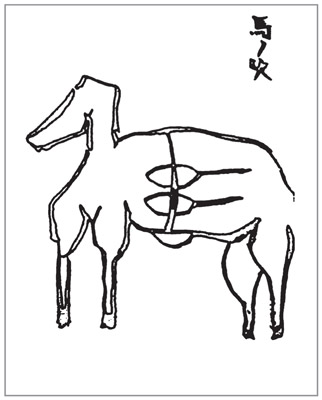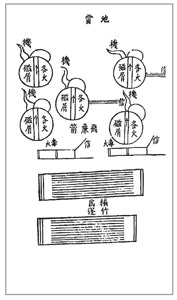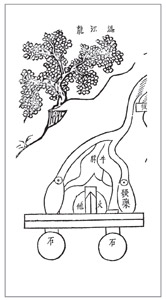In Search of the Niinja (22 page)
Read In Search of the Niinja Online
Authors: Antony Cummins

2 Heki the Wall.
the Wall.
3 Yoku the Wings.
the Wings.
4 Shin the Chariot
the Chariot
That when it does cross these lines, then it is always windy.
The Art of
War continues: ‘Launching an incendiary attack has its appropriate seasons, igniting the fire has its proper days, as for the seasons then it is the time of the dry spell [to ignite fires].’
The
shinobi-uta
or ninja poems attributed to the famous Yoshimori appear to emulate this:


To make fire you should learn the way in accordance with the four seasons. It is inadvisable if you make fire without this knowledge.
Sun Tzu says: ‘Winds that arise in the daytime and those that arise at night will stop.’ The
shinobi-uta
poems state:


When you intend to set fire to the castle or camp, you should wait for a wind just before dawn.
Sawyer states that in ancient China, if a fire was to start, then only those people allotted the task of fire control could respond to it, to maintain defences. The ninja section of the
Gunpo Jiyoshu
has the following similar command:
In the case of a fire, send four or five foot soldiers to notify others of the fire; let those with Tobikuchi or Kumade rakes stay there, but the leader should go around patrolling, this is done to watch out for enemy [attacks]. If you find the enemy on a secret night attack, hiding behind the wall or fence, you should get your shooting weapons armed or beat a drum or something similar.
The Chinese manuals are full of animal delivery systems that use nature’s fear of fire to encourage an animal to take fire to the enemy and burn their positions. Of these the most well know are the ‘Fire Oxen’, which included elaborate dummies packed with explosives and other ingenious devices. The use of animals and fire on the battlefield was not a secret weapon, these animals would have been ‘decorated’ and ‘dressed up’ to arouse fear. The shinobi scrolls of the
Gunpo Jiyoshu
reference a ‘Heat Horse’ which is used to incite fear and confusion in the enemy troops:
On a night attack you can place torches on horseback and drive the horse into the enemy. Attaching the torches upside down is also a good method. The amount is dependent upon the enemy. The horse should be a packhorse. The torches should be tied up with a short rope, with a single loop, to a packsaddle so that it will burn up in a short time.
The
Izu-ryu Kohi no Furoku
, a scroll of unknown date and reliability, displays the image of the ‘Fire Horse’, with the torches attached to the sides of the animal.

The Fire Horse of the
Izu-ryu
school.
The use of animals to launch incendiary attacks is not limited to driving pack animals into the enemy. Whilst the following is only a theory, it is a possible connection between Chinese warfare and the ninja skills of the Hattori family of Iga. The
Shinobi Hiden
manual lists
Kotori No Koto
or ‘The Art of Small Birds’ yet does not explain the skill nor its application and neither does it list it in the fire section, but it appears in a section of mixed skills. However, it is still of major interest to find a skill utilising small birds. Many Chinese manuals contain the art of using birds as a fire delivery system. The
T
’
ai-pai Yin-ching
states: ‘Hollow out apricot cores and stuff them with burning moxa, and tie them to the feet of [small] birds.
60
Toward dusk, release the flock so that they will fly into the city to roost for the night.’

The Chinese landmine.

A Chinese sub-aquatic mine.
Some manuals claim (unsurprisingly) that this is impractical and would need to be tested!
The
Uzumihi
or landmine appears in the
Bansenshukai
, the
Gunpo Jiyoshu
and the
Shinobi Hiden
and is regarded as highly secret. The concept itself is simple and pragmatic, the only problem with this weapon is the trigger mechanism. To trigger the landmine, live embers are needed, which creates two problems, first, keeping the embers live and second, not discharging the weapon prematurely. This is most definitely a Chinese weapon and exists in a few versions, both subterranean and sub-aquatic, and contemporary Chinese writers showed the problematic nature of keeping the fuse burning. The
Bansenshukai
version contains fuses held within bamboo tubes that would break when an enemy stepped upon them; this method appears simplistic next to Chinese examples. One ingenious Chinese method was a cog mechanism that when pulled would create a spark and detonate the mine, however it required a man on constant standby in hiding with a long length of string.
